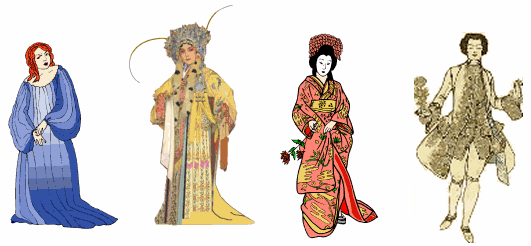|
Wearing the clothes of the other sex has a long tradion in the theater. In many cultures for many centuries women were not allowed to act on the stage, and thus all female roles had to be played by men or boys. Examples of this are the “Peking Opera” and the Japanese Kabuki. In Western countries, the best known example is the English theater at the time of Shakespeare. He and his fellow dramatists had all female parts in their plays performed by “boy actors”, i.e. young males around the age of puberty who could and did convince their audiences as Ophelia, Juliet, Cleopatra, and Lady Macbeth. Finally, in later the 17th century, actresses and female opera singers were permitted, but the greatest opera stars were castrati, i.e. castrated males with very high voices. When these high male voices for male characters became unavailable in the 19th century, a curious reversal took place: Their parts were taken over by female singers in male costume, i.e. in so-called “trouser roles”. Indeed, some composers soon took advantage of this development and deliberately wrote such roles for their new operas. Other examples of theatrical cross dressing are the traditional British Christmas Pantomime with Prince Charming being played by a woman and the “principal boy” played by a girl, or the play “Peter Pan” with Peter played by an actress, or modern television personalities like “Dame Edna” played by a man.
However, this theatrical cross dressing is not considered transvestism in the modern sense of the term, and it does not say anything about the sexual interests or behavior of the performers. While one cannot exclude it in every case, it probably has no sexual signifiance for them at all. Some famous Asian actors of female roles were known for their homosexuality, but it would be wrong to consider them typical. For most performers then and now, it was and is simply another acting or singing job. The case may be different for certain modern “female impersonators” in so-called travesty shows, but even then one should not presume anything about their self-identification, erotic interest, or sexual orientation. Their stage lives and their private lives may have less in common than it seems.
 |
Cross dressing on the stage
From the left: Boy actor playing Lady Macbeth in Shakespeare’s theater
Male actor playing a princess in the “Peking Opera”
Male actor (onnagata) playing a female role in the Japanese Kabuki
Female mezzosoprano in the “trouser role” of Octavian in Richard Strauss’ opera “Der Rosenkavalier”
|